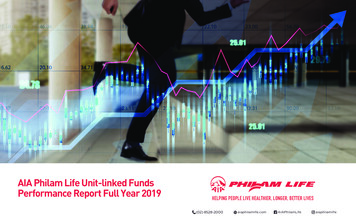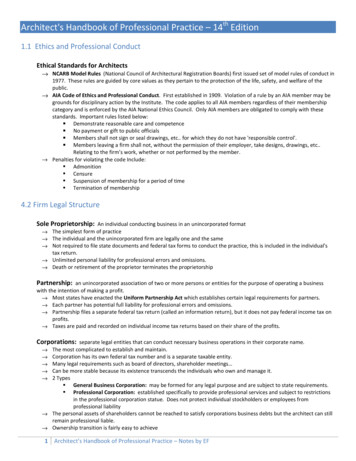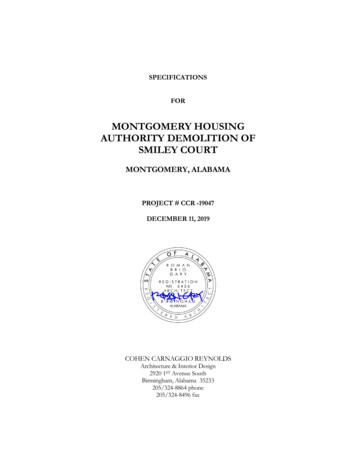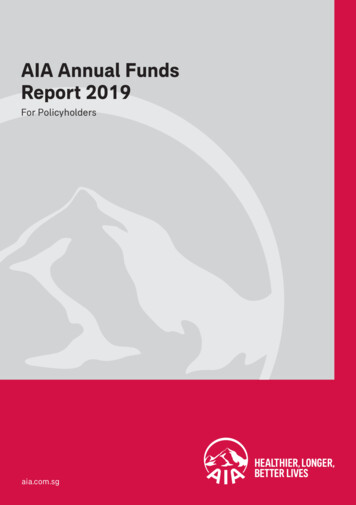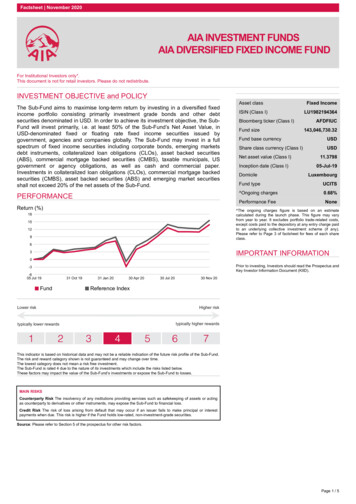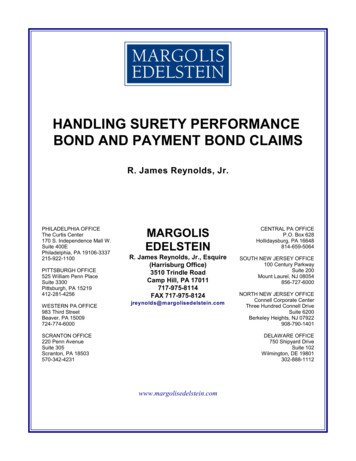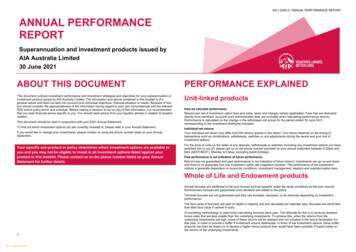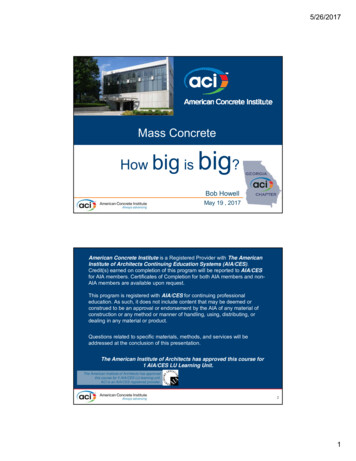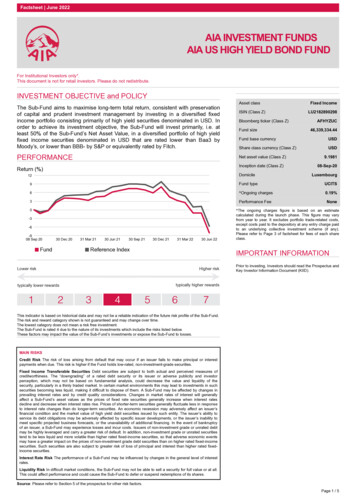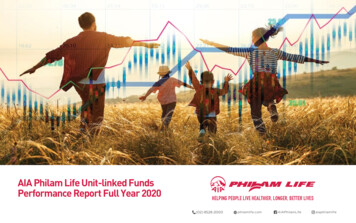
Transcription
AIA Philam Life Unit-linked FundsPerformance Report Full Year 2020HELPING PEOPLE LIVE HEALTHIER, LONGER, BETTER LIVES(02) 8528-2000philamlife.comAIAPhilamLifeaiaphilamlife
About AIAAbout AIA Philam LifeThe Philippine American Life and General Insurance Company (AIA Philam Life) is thecountry’s premier life insurance company. Established on 21 June 1947, AIA Philam Life hasearned the trust of customers for its financial strength, strong brand name, and ability todeliver on its promises.AIA Philam Life has PHP291.63 billion in total assets and PHP80.20 billion in net worth as of 31December 2020, while serving over 800,000 individual policyholders and almost 1,000,000insured group membersAIA Philam Life is a member of AIA Group Limited, the largest independent publicly listedpan-Asian life insurance group.About the Philam GroupThe Philam Group comprises the biggest life insurance group in the Philippines. By putting itscustomers at the center of its operations, the Philam Group has earned the trust of itsstakeholders and has achieved continued growth over the years.The Philam Group was formed with the mission of racing against risk to empower Filipinos tolive healthier, longer, better lives. Through its strong network, it is able to offer financialsolutions such as life protection, health insurance, savings, education, retirement, investment,group and credit life insurance, and fund management products and services.AIA Group Limited and its subsidiaries (collectively “AIA” or the “Group”)comprise the largest independent publicly listed pan-Asian life insurancegroup. It has a presence in 18 markets – wholly-owned branches andsubsidiaries in Mainland China, Hong Kong SAR1, Thailand, Singapore,Malaysia, Australia, Cambodia, Indonesia, Myanmar, the Philippines, SouthKorea, Sri Lanka, Taiwan (China), Vietnam, Brunei, Macau SAR2 and NewZealand, and a 49 per cent joint venture in India.The business that is now AIA was first established in Shanghai more than acentury ago in 1919. It is a market leader in Asia (ex-Japan) based on lifeinsurance premiums and holds leading positions across the majority of itsmarkets. It had total assets of US 326 billion as of 31 December 2020.AIA meets the long-term savings and protection needs of individuals by offeringa range of products and services including life insurance, accident and healthinsurance and savings plans. The Group also provides employee benefits,credit life and pension services to corporate clients. Through an extensivenetwork of agents, partners and employees across Asia, AIA serves the holdersof more than 38 million individual policies and over 16 million participatingmembers of group insurance schemes.AIA Group Limited is listed on the Main Board of The Stock Exchange of HongKong Limited under the stock code “1299” with American Depositary Receipts(Level 1) traded on the over-the-counter market (ticker symbol: “AAGIY”).After the establishment of AIA Philam Life in 1947, the Philam Group has since expanded toinclude other affiliate companies, namely: BPI-Philam Life Assurance Company (BPLAC),Philam Asset Management Inc. (PAMI), and Philam Foundation.Based on the Insurance Commission results as of 31 December 2020, the combined totalpremium income of AIA Philam Life and BPLAC is at PHP33.06 billion.12Hong Kong SAR refers to Hong Kong Special Administrative Region.Macau SAR refers to Macau Special Administrative Region.
31 May 2021Dear Policyholder,With the entire world reeling from the economic impact of the pandemic,countries had to rely on the extraordinarily large government stimulus packagesand central bank interventions to prevent the worst financial outcomeseverywhere including the Philippines.These interventions helped increase the supply of money which boosted the localbond market. At the same time, the “bounce” in the price of risk assets fueledgains in the local US dollar-denominated bond market.Amid the uncertain economic landscape, it was not surprising that investors andcompanies were adamant to spend and held on to their assets. These, coupledwith the implosion in corporate profits, caused the local stock market to retreat,ending the year with a dismal performance.And while 2020 was generally not the best year for investments, there were somegains in the performance of the AIA Philam Life Funds. Bond funds performedbetter than balanced and equity funds, with the Philam Life Fixed Income Fund,PAMI Philam Bond Fund, Philam Life Dollar Bond Fund and Philam Life GlobalBond Fund as the best-performing funds for the year.Bond Funds2020 ReturnCurrencyPhilam Life Fixed Income Fund6.44%Peso6.24%PesoPAMI Philam Bond Fund5.42%DollarPhilam Life Dollar Bond Fund5.70%DollarPhilam Life Global Bond FundBalanced FundsPhilam Life Balanced FundPAMI Philam FundEquity FundsPhilam Life Equity FundPAMI Philam Strategic Growth FundPAMI Philam Equity Index oPesoNew FundsCumulative ReturnSince InceptionPhilam Life Equity Capped Index Fund 7.17%Philam Life Short Term Fund-0.01%0.21%Philam Life Long Term Bond 07/202009/07/2020Overall, AIA Philam Life continues to maintain its financial strength, enabling theCompany to withstand the challenges brought about by the pandemic.2020 AIA Philam Life PerformanceTotal AssetsNet WorthPaid up CapitalGross PremiumsNet Income:::::PHP291.6 billionPHP80.2 billionPHP1.9 billionPHP18.5 billionPHP5.5 billionThank you for your loyalty and continued patronage. We at AIA Philam Liferemain committed to fulfilling our mission of racing against risk through oursuite of products and services that not only protects you, but also helps you growyour long-term savings, empowering you to live Healthier, Longer, and BetterLives.For any inquiries, please do not hesitate to call us at ( 632) 8528-2000 or e-mailus at philamlife@aia.com. You may also visit our website at www.philamlife.comor drop by the nearest AIA Philam Life Customer Service Center.Kelvin AngChief Executive Officer
2020 ANNUAL REPORTAIA PHILAM LIFE VARIABLE FUNDSGeneral Market OverviewThe 2019 novel coronavirus swept across the world throughout most of 2020, crippling economic growth and adversely affecting the lives of many segments of theglobal population. This prompted extraordinarily large government stimulus packages and central bank interventions.In the Philippines, the swift and massive actions of the Bangko Sentral ng Pilipinas (BSP) to increase the supply of money in circulation boosted the local bond market,delivering 12.8 per cent in returns for the year. The bounce in the price of US dollar-denominated government bonds also fueled gains in the local US dollar-denominated fixed income market, delivering a return of 7.38 per cent.The scarcity of confidence among individuals and businesses to spend and the record implosion in corporate profits, however, caused the stock market to retreat 8.64per cent. While this is not the first time its performance has disappointed, its record of the last 10 years has been respectable at a compounded annual growth rate of7.7 per cent.The Local EconomyIn March 2020, the World Health Organization (WHO) declared the widespread contagion from the COVID-19 virus a pandemic. This prompted governments to imposerestrictions on their citizens as to mass gatherings, mobility/ travel, and non-essential services, thus triggering a severe collapse in economies everywhere. In thePhilippines, gross domestic product (GDP) contracted 9.6 per cent – the worst among 67 economies after Peru, as monitored by Bloomberg.All sectors of the PHP19.5 trillion economy contracted, except the government. Household final consumption expenditure, which accounts for 72 per cent of totalexpenditures, shrank 7.9 per cent. Spending on construction and durable equipment collapsed 29.7 per cent and 31.3 per cent, respectively. Output in constructiondeclined 26 per cent. In nominal terms, imports collapsed by PHP2 trillion. Services, which account for 61 per cent of total output, contracted 9.1 per cent.As capacity utilization in manufacturing dipped to its all-time low of 67 per cent, 4.8 million Filipinos added to the unemployed of 7.2 million. Income from abroadshrank 27.3 per cent. In nominal terms, the money earned by individuals and businesses, or Gross National Income, narrowed by PHP2 trillion.Local Fixed Income MarketTo support the economy, the Bangko Sentral ng Pilipinas (BSP) lowered the rate at which it lends (overnight) to banks, five times, in February (25 basis points), March(50), April (50), June (50), and finally, in November (25), to 2 per cent.In April, as unemployment peaked, the BSP cut banks’ reserve requirement ratio and lent government (or purchased government securities worth) PHP352 billion, anamount that was larger than any lending to the government in a year except 2019. Consequently, yields of government bonds witnessed their largest month-on-monthdecline (123 basis points, based on the benchmark Bloomberg Philippine Sovereign Bond Index AI) since the financial crisis of 2008-09 (US housing bubble andbankruptcy of Lehman Brothers).
Despite the lowest overnight lending rate, the loan portfolios of financial institutions shrank PHP34 billion in 2020 – a first since 2002. Foreign banks scaled backPHP80 billion, even as private and state-owned banks added PHP45 billion.Resolute in its action, the BSP lent the government another PHP596 billion, as confidence among consumers collapsed to historic lows. Government bond yields sankto their all-time low of 2.64 per cent in July, before closing the year at 2.65 per cent, from 4.28 per cent in end-2019.The unprecedented response of the BSP lifted the benchmark index to 131.82, delivering another 12.8 per cent of return in 2020, after recording its best calendarreturn on record (23.1 per cent) the year before.Guided by the ‘lower for longer’ policy of monetary authorities and encouraged by excess liquidity in the financial system, duration in the fixed income funds was keptoverweight relative to their benchmarks for the better part of the year.Local Equity MarketThe recovery in risk assets did not facilitate positive investment returns from Philippine stocks.By the end of February, the benchmark Philippine Stock Exchange Index had retreated 13 per cent to 6,787, as negative developments piled in, one after the other.Economic activity in the surrounding areas near the Taal Volcano was halted for weeks. The Duterte administration announced its review of land leases to leading landdeveloper Ayala Land, Inc. Scrutiny on Philippine online gaming operators heightened. The Solicitor General reported filing a quo warranto case (alleged violation in itsfranchise) against largest entertainer ABS-CBN Corporation. A week after the WHO declaration of the pandemic, the benchmark plunged to its eight-year-low of 4,623.As stock prices in advanced and emerging markets bounced in April, local stocks followed but fell back in the third quarter.The BSP reported remittances from overseas workers in July shrinking 19.3 per cent to US 2.1 billion. The 30 benchmark companies reported a 45 per centcontraction in net operating profit after tax in the second quarter – its worst performance in recorded history.The US 2.5 billion in foreign outflows from the local stock market in 2020 did not help.Improved mobility (higher capacity in public transport and entry of inbound Filipinos) later in the year enabled the local market to participate in the global optimismsurrounding the approval of vaccines. Even as the stock prices of 11 names in the benchmark (most of which reported the highest returns on capital) registered gainsof 12.6 per cent, on average, all the same, the implosion in corporate profits and steady increase in new cases of COVID-19 caused the benchmark to decline 8.64 percent to 7,139 – registering its fourth annual loss in the last ten years.In view of the heightened volatility in the stock market, the equity funds stayed Neutral (reduced the portfolio's risk of underperforming, while preserving the potentialfor return) for most of the time.
Global Fixed Income MarketWhile the 2019 novel coronavirus cost the global economy US 3.7 trillion, the large, swift, and unprecedented monetary, fiscal, and regulatory responses of governments avoided the worst financial outcomes.In March, liquidity in fixed income and non-government money market funds deteriorated significantly. Bid-ask spreads threatened their 2008-highs, as fundsexperienced a period of redemptions. In emerging markets, yield spreads in government bonds (based on the J.P. Morgan EMBI Global Spread Index) widened 661basis points over the comparable US Treasuries – their widest in 11 years. The prices of US dollar-denominated Philippine government bonds, as measured by the J.P.Morgan Philippine Total Return Index, fell to a 12-month-low of 285.31.The flight to conservative investments benefitted US Treasury yields, as soon as the WHO declared the outbreak of COVID-19 as a public health emergency ofinternational concern. At the start of February, US Treasury yields recorded 1.50 per cent (based on Bloomberg Barclays US Treasury Index), compared to 1.72 percent at the beginning of 2020. By the end of March, Treasury yields retreated to 0.57 per cent, before dipping to their all-time low of 0.408 per cent in July and closingat 0.57 per cent in December.To boost the risk appetite of investors, the US Federal Reserve Bank adjusted the federal funds target rate from 1.71 per cent in February to 0.25 per cent in March – alevel not seen since the US subprime mortgage crisis. The anticipated and actual demand for assets enabled historic-low interest rates and the recovery in the price ofrisk assets (equities, commodities, high-yield bonds, real estate, and currencies). Demand for US dollar-denominated Philippine government bonds recovered, too.The bond price index rose to 334.48 by the end of 2020, or a year’s gain of 7.38 per cent.Notably, in August, the US Fed announced moving to a flexible strategy in monetary policy that will be driven by the average inflation target of 2 per cent over time.Notwithstanding, the US economy contracted 3.5 per cent, after suffering from the third wave of infections in November. China, which is bigger than Europe and nowtwo-thirds of the size of the US, grew 2.3 per cent. Europe succumbed to a second wave and shrank 6.3 per cent. Japan shrank 4.8 per cent.Encouraged by US monetary authorities’ unprecedented response to support the markets and its economy, the US dollar-denominated funds took advantage of theperiod of redemptions in the market by deploying cash and repositioning in bonds whose prices have dropped significantly, banking on a rebound in credit spreadsafter the initial shock at the onset of the lockdowns.FUND MANAGERSAIA Philam Life’s variable life funds are managed by AIA Philam Life’s team of investment professionals who have 20 to 30 years of experience and expertise in the field of fundmanagement. As of 31 December 2020 total assets under management reached over PHP64.5 billion, excluding those of other AIA Philam Life affiliates. AIA Philam Life combines itsexpertise with the strength of its senior management to manage portfolios effectively to achieve favorable returns.
FINANCIAL STATEMENTAs of 31 December 2020STATEMENT OF ASSETS AND LIABILITIESAIA Philam Life Peso Variable FundsPhilam LifeFixed IncomeFundPhilam LifeEquity FundPhilam Life Philam Life Philam Life Philam Life PAMI Philam PAMI Philam PAMI Philam PAMI PhilamBalanced Equity Capped Long Term Short Term Bond FundFundStrategicEquity IndexFundIndex FundBond FundFundGrowth FundFundAccrued 9-23,454,233,757 11,936,952,02448-Total 3,454,233,757 389,785389,785-8,167,142,475 2,917,399,88523,759,7393,359,452 1,299,8913,875,811,327ASSETSCash and cash equivalentsFinancial assets at FVPL*Loans and receivables-LIABILITIESAccounts payable andaccrued expensesTotal LiabilitiesNet Asset Value (NAV)*Fair Value Through Profit or Loss1,840,421,145--8,436,665,765 23,454,233,757 11,936,952,073
FINANCIAL STATEMENTAs of 31 December 2020STATEMENT OF ASSETS AND LIABILITIESAIA Philam Life Dollar Variable FundsPhilam LifeGlobal BondFundPhilam LifeDollar BondFundHigh-WaterMark Fund2019ASSETSCash and cash equivalentsFinancial assets at FVPL*Loans and receivablesAccrued incomeTotal Assets 756,2657,826,83271,001 1,850,14967,335,639300,000924,20020,772,349- 8,654,098 70,409,988 20,772,349 1,616 1,616 12,952 12,952- 8,652,482 70,397,036 20,772,349LIABILITIESAccounts payable andaccrued expensesTotal LiabilitiesNet Asset Value (NAV)*Fair Value Through Profit or Loss
PHILAM LIFE FIXED INCOME FUNDFund Inception Date: 10 November 2004Fund DescriptionThe Philam Life Fixed Income Fund (PFIF) is a Philippine peso-denominated fund created for variable life insurance contracts issued by The Philippine American Life andGeneral Insurance Company (AIA Philam Life). This investment option is for the variable life policyholder with a preference for investing in high-quality interest-bearing debtinstruments that present low to moderate levels of risk. The investment objective of the PFIF is to provide stable income over the medium- to long-term, and preserve capitalby investing primarily in Philippine peso-denominated fixed income securities issued by the government and reputable corporate issuers.Fund Performance*2020 Return2019 Return2018 Return2017 Return2016 Return2015 Return2014 Return2013 Return2012 Return2011 Return3 Years Return (annualized as of 31 Dec 2020)5 Years Return (annualized as of 31 Dec 2020)Return since Inception (annualized as of 31 Dec 2020)* Fund returns are calculated based on Net Asset Value per UnitPast performance is not indicative of future ar-061.2Nov-04PORTFOLIO STATISTICS (as of 31 Dec 2020)Net Asset Value (NAV in PHP)Net Asset Value per Unit (NAVPU)1,840,421,145*2.3925* Based on Audited Financial Statement. NAV is net of 2.0% fundmanagement charge, transaction cost, and audit fees.PORTFOLIO MIX* (as of 31 Dec 2020)Cash & Cash EquivalentsCorporate SecuritiesPhilippine Issued Peso Government Bonds0.57%5.16%94.27%* Excluding accrued incomeFIXED INCOME SECURITIES (as of 31 Dec 2020)Top 5 IssuesPH Issued PHP Govt BondsPH Issued PHP Govt BondsPH Issued PHP Govt BondsPH Issued PHP Govt BondsPH Issued PHP Govt BondsNAVPU Since 08/12/202509/09/204002/11/202301/10/2029% of Portfolio9.70%8.31%6.06%5.67%5.49%
PHILAM LIFE EQUITY FUNDFund Inception Date: 10 November 2004Fund DescriptionThe Philam Life Equity Fund (PEF) is a Philippine peso-denominated fund created for variable life insurance contracts issued by The Philippine American Life and GeneralInsurance Company (AIA Philam Life). This investment option is for the variable life policyholder aiming for capital appreciation over a long-term investment horizon, andwho has a risk appetite for stock investing. The objective of the PEF is to achieve capital growth by investing in an efficient and diversified portfolio of predominantly growthcompanies while including appropriate value stocks.Fund Performance*2020 Return2019 Return2018 Return2017 Return2016 Return2015 Return2014 Return2013 Return2012 Return2011 Return3 Years Return (annualized as of 31 Dec 2020)5 Years Return (annualized as of 31 Dec 2020)Return since Inception (annualized as of 31 Dec .55%24.44%0.31%-6.84%-0.92%7.52%* Fund returns are calculated based on Net Asset Value per UnitPast performance is not indicative of future performance.NAVPU Since Inception4.23.8PORTFOLIO STATISTICS (as of 31 Dec 2020)Net Asset Value (NAV in PHP)Net Asset Value per Unit (NAVPU)* Based on Audited Financial Statement. NAV is net of 2.0% fundmanagement charge, transaction cost, and audit fees.PORTFOLIO MIX* (as of 31 Dec 2020)Cash & Cash EquivalentsCommon Stocks* Excluding accrued incomeCOMMON STOCKS (as of 31 Dec 2020)Top 5 IssuesAyala Land IncSM Investments CorpSM Prime Holdings IncAyala CorporationBDO Unibank Inc8,167,142,475*3.22268.04%91.96%% of Portfolio10.60%10.08%10.05%8.14%7.91%3.43.0COMMON STOCKS by SECTOR (as of 31 Dec ctorFinancialsIndustrialsConsumer StaplesTelecommunication ServicesConsumer DiscretionaryUtilities% of Portfolio55.90%24.09%7.54%5.78%3.51%3.18%
PHILAM LIFE BALANCED FUNDFund Inception Date: 22 May 2007Fund DescriptionThe Philam Life Balanced Fund (PBAL) is a Philippine peso-denominated fund created for variable life insurance contracts issued by The Philippine American Life andGeneral Insurance Company (AIA Philam Life). This investment option is for the variable life policyholder who aims for long-term capital appreciation by investing primarilyin Philippine peso-denominated equities, equity-related securities and debt securities.Fund Performance*2020 Return2019 Return2018 Return2017 Return2016 Return2015 Return2014 Return2013 Return2012 Return2011 Return3 Years Return (annualized as of 31 Dec 2020)5 Years Return (annualized as of 31 Dec 2020)Return since Inception (annualized as of 31 Dec 2020)* Fund returns are calculated based on Net Asset Value per UnitPast performance is not indicative of future performance.PORTFOLIO STATISTICS (as of 31 Dec 2020)Net Asset Value (NAV in PHP)Net Asset Value per Unit 1PORTFOLIO MIX* (as of 31 Dec 2020)Cash & Cash EquivalentsCorporate SecuritiesPhilippine Issued Peso Government BondsCommon Stocks* Excluding accrued income0.73%2.83%44.98%51.46%COMMON STOCKS (as of 31 Dec 2020)Top 5 IssuesSM Investments CorpSM Prime Holdings IncAyala Land IncAyala CorporationBDO Unibank Inc% of Portfolio8.92%6.22%5.32%3.54%3.36%* Based on Audited Financial Statement. NAV is net of 2.0% fundmanagement charge, transaction cost, and audit fees.NAVPU Since Inception2.3FIXED INCOME SECURITIES (as of 31 Dec 80.5Top 5 IssuesPH Issued PHP Govt BondsPH Issued PHP Govt BondsPH Issued PHP Govt BondsPH Issued PHP Govt BondsPH Issued PHP Govt 02301/10/2029% of Portfolio5.20%4.84%3.81%3.59%2.70%
PHILAM LIFE DOLLAR BOND FUNDFund Inception Date: 12 July 2005Fund DescriptionThe Philam Life Dollar Bond Fund (PALDBF) is a US dollar-denominated fund created for dollar variable life insurance contracts issued by The Philippine American Life andGeneral Insurance Company (AIA Philam Life). This investment option is for the variable life policyholder with a preference for investing in US dollar-denominated Philippinegovernment and corporate fixed-income securities. The Fund aims to provide income growth while maintaining moderate liquidity over the medium- to long-term.Fund Performance*2020 Return2019 Return2018 Return2017 Return2016 Return2015 Return2014 Return2013 Return2012 Return2011 Return3 Years Return (annualized as of 31 Dec 2020)5 Years Return (annualized as of 31 Dec 2020)Return since Inception (annualized as of 31 Dec 2020)* Fund returns are calculated based on Net Asset Value per UnitPast performance is not indicative of future performance.NAVPU Since InceptionPORTFOLIO STATISTICS (as of 31 Dec 2020)Net Asset Value (NAV in US )Net Asset Value per Unit (NAVPU)* Based on Audited Financial Statement. NAV is net of 2.0% fundmanagement charge, transaction cost, and audit fees.PORTFOLIO MIX* (as of 31 Dec 2020)Cash & Cash EquivalentsLoans & ReceivablesForeign Bond SecuritiesPhilippine Issued Dollar Government 3%42.84%52.92%* Excluding accrued incomeTop 5 IssuesPH Issued US Govt BondsPH Issued US Govt BondsPH Issued US Govt BondsPH Issued US Govt BondsPH Issued US Govt Bonds2.2Oct-0670,397,036*2.3749FIXED INCOME SECURITIES (as of 31 Dec /23/203402/02/203003/16/202501/20/2040% of Portfolio12.65%7.72%6.69%5.23%5.02%
PHILAM LIFE GLOBAL BOND FUNDFund Inception Date: 12 July 2005Fund DescriptionThe Philam Life Global Bond Fund (PALGBF) is a US dollar-denominated fund created for dollar variable life insurance contracts issued by The Philippine American Life andGeneral Insurance Company (AIA Philam Life). This investment option is for the variable life policyholder with a preference for investing in US dollar-denominatedhigh-quality, investment-grade fixed-income securities with low to moderate levels of risk. The Fund aims to preserve capital and provide stable income growth over themedium- to long-term.Fund Performance*2020 Return2019 Return2018 Return2017 Return2016 Return2015 Return2014 Return2013 Return2012 Return2011 Return3 Years Return (annualized as of 31 Dec 2020)5 Years Return (annualized as of 31 Dec 2020)Return since Inception (annualized as of 31 Dec 70%2.81%2.54%2.23%3.55%* Fund returns are calculated based on Net Asset Value per UnitPast performance is not indicative of future performance.NAVPU Since .1Oct-06Net Asset Value (NAV in US )Net Asset Value per Unit (NAVPU)8,652,482*1.7166* Based on Audited Financial Statement. NAV is net of 2.0% fundmanagement charge, transaction cost, and audit fees.PORTFOLIO MIX* (as of 31 Dec 2020)Cash & Cash EquivalentsForeign Corporate Securities8.81%91.19%* Excluding accrued incomeFIXED INCOME SECURITIES (as of 31 Dec 2020)Top 5 IssuesHuarong Finance Co LtdVanke Real Estate Hong KongRoyal Capital VariableReliance Industries Ltd.ICTSI International Bonds1.81.0PORTFOLIO STATISTICS (as of 31 Dec 02506/17/2030% of Portfolio4.73%3.82%3.81%3.55%3.07%
PHILAM LIFE EQUITY CAPPED INDEX FUNDFund Inception Date: 3 March 2020Fund DescriptionThe Philam Life Equity Capped Index Fund (PECIF) is a Philippine peso-denominated fund created for variable life insurance contracts issued by The Philippine American Lifeand General Insurance Company (AIA Philam Life). It is an investment option for variable life policyholders comfortable with the risk associated with long-term capitalgrowth. The fund invests in a basket of stocks that comprise the Philippine Stock Exchange Index (PSEi) in such similar proportion as that of the PSEi but with modifiedexposure limits or caps.Fund Performance*1 Month Return3 Months Return6 Months ReturnReturn since Inception (annualized as of 31 Dec 2020)* Fund returns are calculated based on Net Asset Value per UnitPast performance is not indicative of future performance.4.76%20.63%14.46%7.17%PORTFOLIO MIX* (as of 31 Dec 2020)Cash & Cash EquivalentsCommon Stocks5.74%94.26%* Excluding accrued incomeCOMMON STOCKS (as of 31 Dec 2020)NAVPU Since InceptionTop 5 IssuesSM Prime Holdings IncAyala Land IncSM Investments CorpAyala CorporationJG Summit Holdings Inc1.11.00.9% of Portfolio9.95%9.77%9.70%7.65%6.73%COMMON STOCKS by SECTOR (as of 31 Dec -20Apr-200.7Mar-200.8PORTFOLIO STATISTICS (as of 31 Dec 2020)Net Asset Value (NAV in PHP)Net Asset Value per Unit (NAVPU)23,759,739 *1.0716* Based on Audited Financial Statement. NAV is net of 2.0% fund managementcharge, transaction cost, and audit fees.SectorFinancialsIndustrialsConsumer StaplesTelecommunication ServicesConsumer DiscretionaryUtilities% of Portfolio50.59%27.99%8.24%5.27%4.01%3.90%
PHILAM LIFE LONG TERM BOND FUNDFund Inception Date: 7 September 2020Fund DescriptionThe Philam Life Long Term Bond Fund (PLTBF) is a Philippine peso-denominated fund created for variable life insurance contracts issued by The Philippine American Lifeand General Insurance Company (AIA Philam Life). It is an investment option for variable life policyholders comfortable with the risk associated with long-term investing. Thefund invests primarily in Philippine peso-denominated fixed income securities issued by the Philippine Government.Fund Performance*1 Month Return3 Months ReturnReturn since Inception (annualized as of 31 Dec 2020)* Fund returns are calculated based on Net Asset Value per UnitPast performance is not indicative of future performance.0.31%0.25%0.21%PORTFOLIO STATISTICS (as of 31 Dec 2020)Net Asset Value (NAV in PHP)Net Asset Value per Unit (NAVPU)3,359,452*1.0021* Based on Audited Financial Statement. NAV is net of 2.0% fundmanagement charge, transaction cost, and audit fees.PORTFOLIO MIX* (as of 31 Dec 2020)NAVPU Since InceptionCash & Cash EquivalentsPhilippine Issued Peso Government Bonds1.0060* Excluding accrued income1.00401.73%98.27%1.00201.0000FIXED INCOME SECURITIES (as of 31 Dec -200.9920Top 5 IssuesPH Issued PHP Govt BondsPH Issued PHP Govt BondsPH Issued PHP Govt BondsPH Issued PHP Govt BondsPH Issued PHP Govt 02904/21/2023% of Portfolio10.21%8.16%7.44%7.14%5.15%
PHILAM LIFE SHORT TERM BOND FUNDFund Inception Date: 7 September 2020Fund DescriptionThe Philam Life Short Term Fund (PSTF) is a Philippine peso-de
gains in the performance of the AIA Philam Life Funds. Bond funds performed better than balanced and equity funds, with the Philam Life Fixed Income Fund, PAMI Philam Bond Fund, Philam Life Dollar Bond Fund and Philam Life Global Bond Fund as the best-performing funds for the year. Bond Funds 2020 Return Currency
